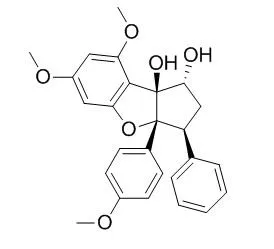| Kinase Assay: |
| Anticancer Res. 2006 Mar-Apr;26(2A):947-52. | | Rocaglaol induces apoptosis and cell cycle arrest in LNCaP cells.[Pubmed: 16619491] |
METHODS AND RESULTS:
Rocaglaol is a cytotoxic cyclopenta[b]benzofuran isolated from the bark of Aglaia crassinervia. It exhibited in vitro cytotoxic activity against Lu1, LNCaP and MCF-7 cells with ED50 values of 13.8, 23.0 and 9.2 nM, respectively. DAPI staining indicated that LNCaP cells treated with Rocaglaol underwent apoptosis.
In order to determine whether Rocaglaol-induced apoptosis is mediated by the mitochondrial pathway, apoptosis-related mitochondrial-associated proteins were studied. Rocaglaol treatment induced Bax expression through 12 to 72 h of exposure, while Bcl-xl expression was slightly decreased through 48 h, and decreased more significantly by 72 h.Since Rocaglaol caused dose-dependent G2/M phase arrest of LNCaP cells as indicated by flow cytometric analysis, the protein levels of cell cycle-related genes were measured. Rocaglaol treatment (230 nM) did not change cyclin B after 24- to 60-h treatment. The expression of cdc2 was not changed and phospho-cdc2 (Tyr 15) increased after 36-, 48- and 60-h treatment. In addition, protein phosphatase Cdc25C, which functions as a mitotic activator by dephosphorylation of Cdc2, decreased in a time-dependent manner after Rocaglaol treatment.
CONCLUSIONS:
Taken together, these results suggest that Rocaglaol is a potent anticancer drug that induces apoptosis of LNCaP cells through the mitochondrial pathway and its G2/M-phase cell cycle arrest is associated with the down-regulation of Cdc25C and the dephosphorylation of Cdc2. | | Mol Pharmacol. 2005 May;67(5):1544-55. | | A synthetic derivative of the natural product rocaglaol is a potent inhibitor of cytokine-mediated signaling and shows neuroprotective activity in vitro and in animal models of Parkinson's disease and traumatic brain injury.[Pubmed: 15716464] | Many acute and chronic neurodegenerative diseases are characterized by a localized inflammatory response and constitutive activation of the transcription factors nuclear factor-kappa B (NF-kappa B) and activator protein-1 (AP-1) as well as their upstream activating signaling cascades. Ample evidence indicates the implication of these processes in the pathogenesis of several diseases of the central nervous system.
METHODS AND RESULTS:
In this study, we show that a synthetic derivative of the natural product Rocaglaol (compound A) displays potent anti-inflammatory properties in human endothelial and murine glial cells in vitro. Compound A inhibited cytokine- and lipopolysaccharide-induced release of various cytokines/chemokines and of nitric oxide as well as expression of the adhesion molecule endothelial leukocyte adhesion molecule-1 and the inducible enzymes nitric-oxide synthase and cyclooxygenase-2. As shown by immunocytochemistry and immunoblotting, compound A inhibited NF-kappa B and AP-1 activity in mixed glial cultures. Compound A exhibited neuroprotective activity in vitro and in vivo. 1-Methyl-4-phenylpyridinium-induced damage of mesencephalic dopaminergic neurons was significantly decreased, and long-term treatment of 1-methyl-4-phenyl-1,2,3,6,-tetrahydropyridine-injected mice with compound A significantly and dose-dependently reduced dopaminergic neuronal cell death. In addition, shortterm application of compound A to rats suffering from traumatic brain injury induced by subdural hematoma resulted in a significant reduction of the cerebral infarct volume.
CONCLUSIONS:
These results suggest that by inhibiting NF-kappa B and AP-1 signaling, compound A is able to reduce tissue inflammation and neuronal cell death, resulting in significant neuroprotection in animal models of neurodegeneration. |
|






 Cell. 2018 Jan 11;172(1-2):249-261.e12. doi: 10.1016/j.cell.2017.12.019.IF=36.216(2019)
Cell. 2018 Jan 11;172(1-2):249-261.e12. doi: 10.1016/j.cell.2017.12.019.IF=36.216(2019) Cell Metab. 2020 Mar 3;31(3):534-548.e5. doi: 10.1016/j.cmet.2020.01.002.IF=22.415(2019)
Cell Metab. 2020 Mar 3;31(3):534-548.e5. doi: 10.1016/j.cmet.2020.01.002.IF=22.415(2019) Mol Cell. 2017 Nov 16;68(4):673-685.e6. doi: 10.1016/j.molcel.2017.10.022.IF=14.548(2019)
Mol Cell. 2017 Nov 16;68(4):673-685.e6. doi: 10.1016/j.molcel.2017.10.022.IF=14.548(2019)